Thursday 6th April 2023

As well as bright green buses in the West of England from Monday (see Tuesday’s blog), this week has also seen the launch of a fleet of bright green buses on a new circular bus route around Leicester city centre. I paid a visit on Tuesday to take a look.

Branded as hop! the new free to use bus route is operated by Centrebus on behalf of the city council with three Yutong E9 battery/electric midibuses.
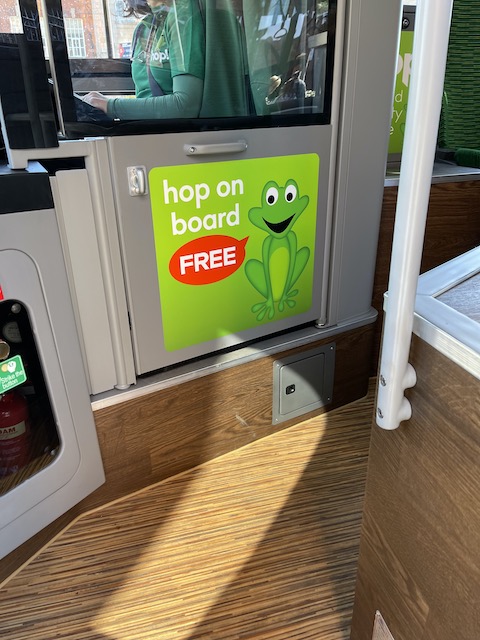
hop! began on Monday having been officially launched to various dignitaries and the media on 14th March. Buses run every 10 minutes between 08:00 and 18:00 Monday to Saturday on an anti-clockwise loop with a round trip time of about twenty minutes therefore requiring two buses. A third bus comes out at busy times enabling the round trip time to extend up to 30 minutes in case of traffic delays.

As you’d expect from Leicester City Council, which has become something of a trail blazing authority for promoting buses, the publicity and information about hop! is excellent.
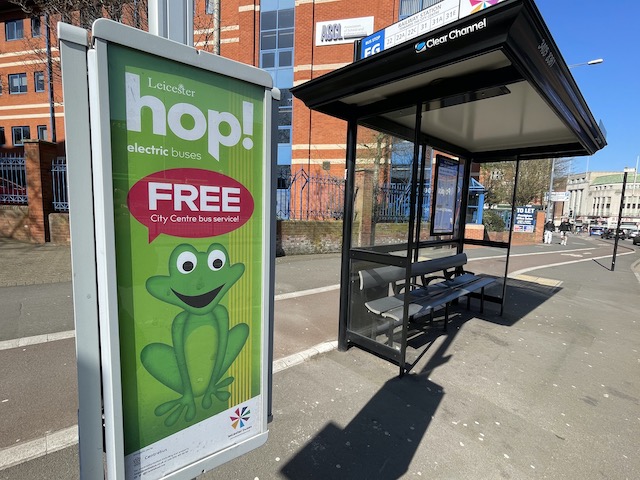
There’s a colourful leaflet with a map showing the one-way circuit the bus takes with the 12 bus stops it uses all clearly marked along with their letter codes …

…. which you can easily find on the panels above the bus shelters, with the bus stops across the entire city centre including the two bus stations all being colour coded.
The renowned cartographer Doug Rose (from the original FWT company) does all this excellent work for the Council and he explained the background to me when we met up a few months ago. It’s great to see a professional input from someone who really understands buses and way-finding.

Leicester is also very good at ensuring everything is in place at the stops and shelters and it came as no surprise to find even on day two everything was on display and easy to find.
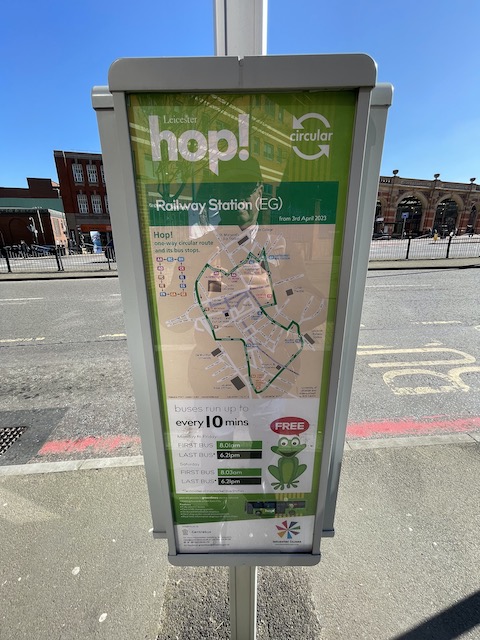
As previously blogged both Haymarket and St Margaret’s bus stations have staff on duty at information desks and the very knowledgeable lady at Haymarket had no hesitation in giving me a hop! leaflet when asked.
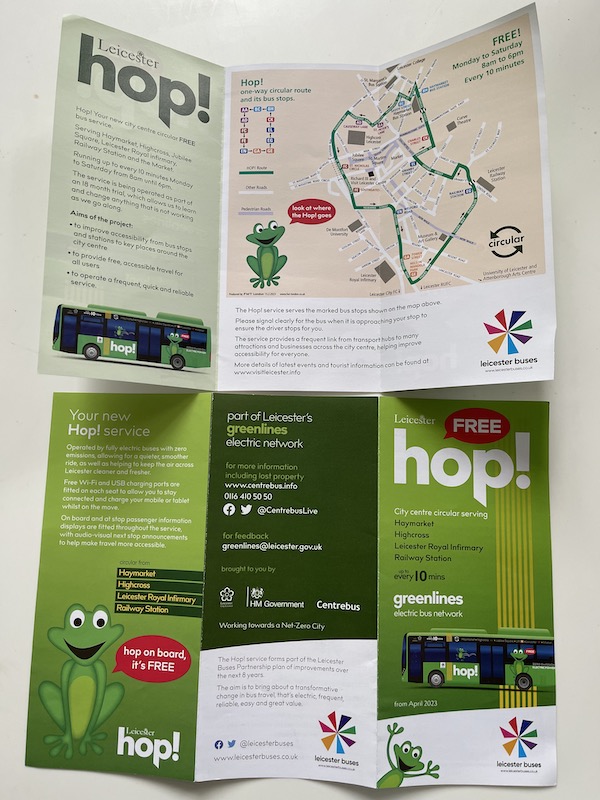
Supplies of leaflets were also available on both buses I travelled on and I saw quite a few passengers taking one. That’s the way to do it.
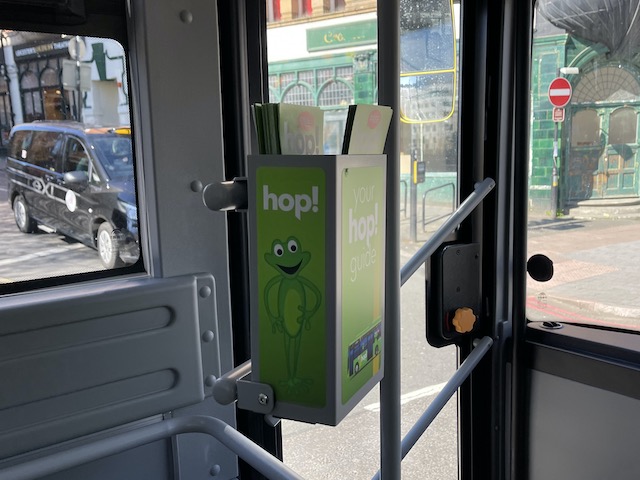
There’s a hop! bus stop opposite the railway station and then unlike other bus routes the hop! bus penetrates the central pedestrian priority area during which drivers switch on a warning ‘ribbet’ sound comprising a frog croaking and a clanging bell every few seconds to make up for the silent engine. I uploaded examples on my Twitter account available to view and hear here.
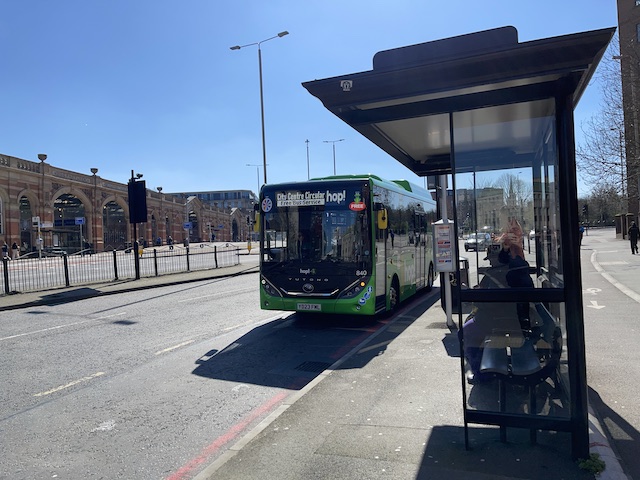
I asked the driver if she found it annoying – it is rather intrusive especially at the front of the bus – but it was only her first day on the route so the novelty hadn’t quite worn off.
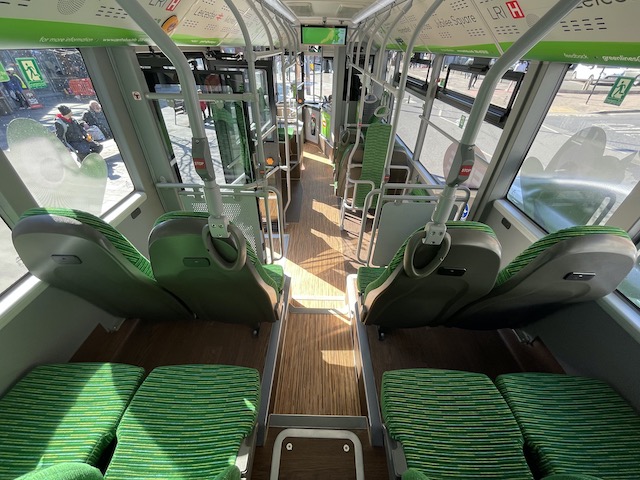
The bus has 21 seats with a centre door for access to the wheelchair space because the short overhang at the front makes for a narrower than usual front entrance door and the gangway width is also narrower than on a standard bus. But this has allowed for six seats (in 2+1 format) immediately behind the front wheel arhces …
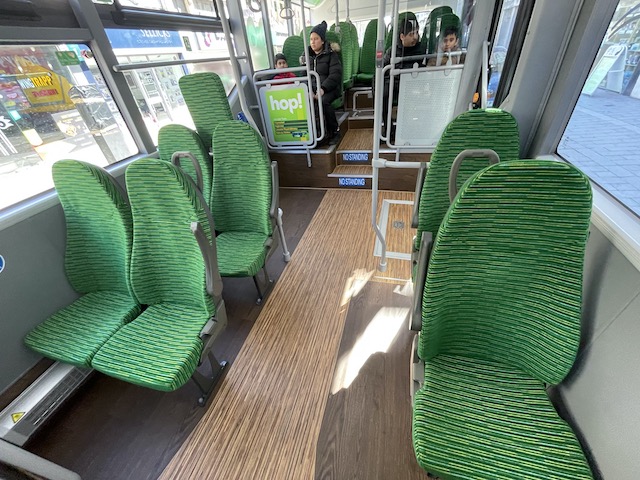
…. with a single seat either side of, and facing, the narrow gangway over each wheel.
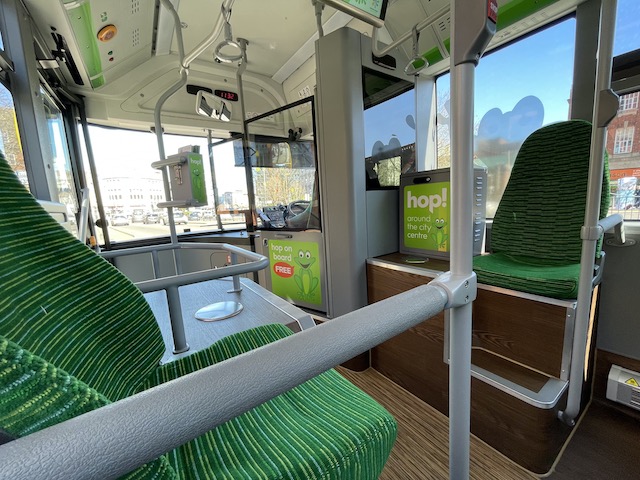
The raised rear section behind the centre exit has 13 seats including five along the back row and there are also two tip up seats in the area for wheelchairs.

On a route of this kind 21/23 seats will be more than sufficient and although legroom in the rear seats wasn’t great, it doesn’t matter for so short a ride.
My observations on Tuesday showed hop! was already creating interest with six passengers on one journey I boarded and threes and fours on others which isn’t bad for a second day.
There’s a small refrigerator-looking locked cupboard immediately behind the driver which I’m guessing is something to do with the electrics/battery.
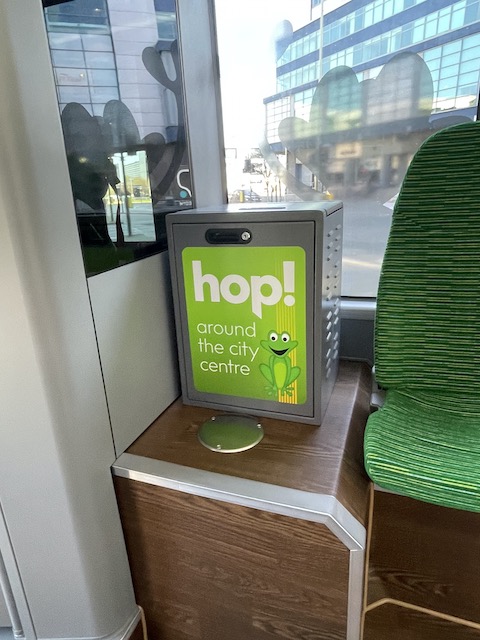
The buses come with Wi-Fi as well as usb sockets which is a bit of a luxury for such a short route but is a welcome standard to keep to – and no, the bus battery doesn’t take power from your phone when you plug it in, it IS the other way round.
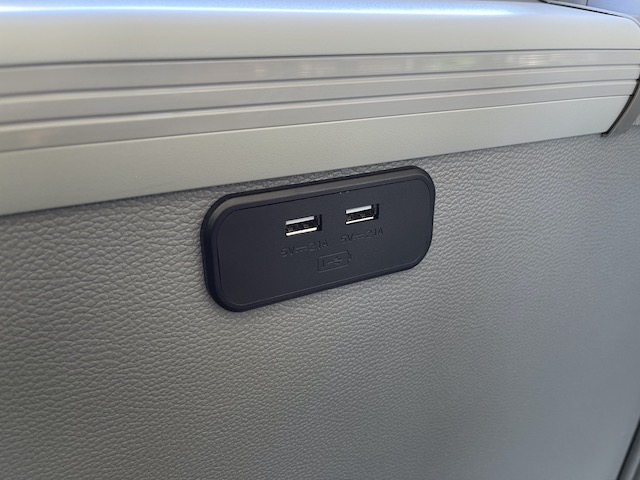
The hop! route takes in key destinations and attractions located around Leicester’s central area and the 10 minute frequency is the optimum for a service of this kind, meaning not too long to wait relative to the journey time.
After the croak sounding section of route through the shopping area the bus arrives at a new stop installed alongside an entrance to Haymarket bus station and just a short stroll from nearby St Margaret’s.
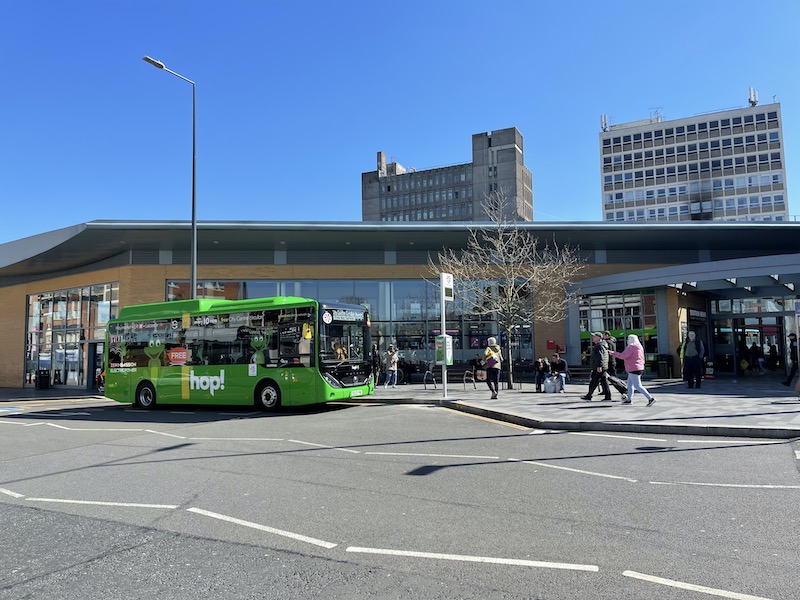
This and other bus stop flags feature real time departure information including voice activation through an in built speaker by pressing a button.

Hopefully this new stop which was proving quite popular during my visit will gain a shelter soon too.

I was impressed to see an enforcement officer standing by and encouraging private hire drivers not to use it as a setting down/picking up/dwell point as had been the practice.
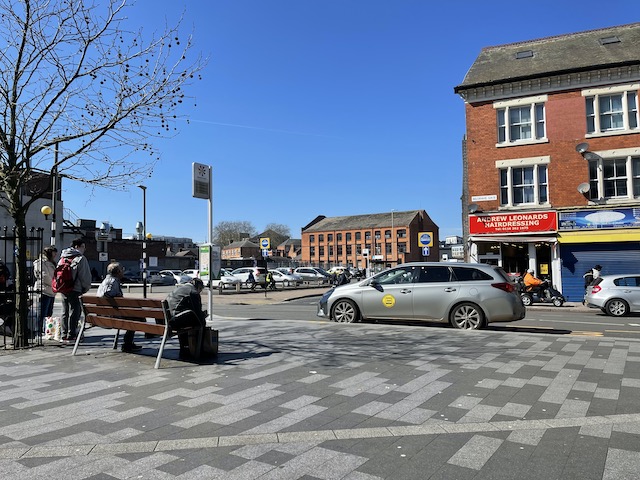
The livery is certainly bright and the frog imagery takes me back to the famous National Express Beeper the Frog campaign when the deregulated era for coaches began in 1980.

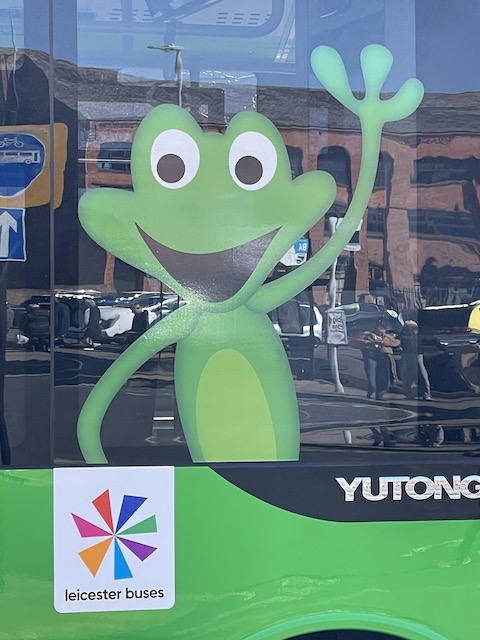
Journeys are relatively short on hop! so I doubt many passengers will worry about the stultified view out of the windows …

… but I still prefer the discipline of not blocking windows. They are for seeing out of not covering over in any way.
These latest battery/electric buses are part of Leicester City Council’s ‘greenlines’ project …

… and has seen Park & Ride buses also upgraded…
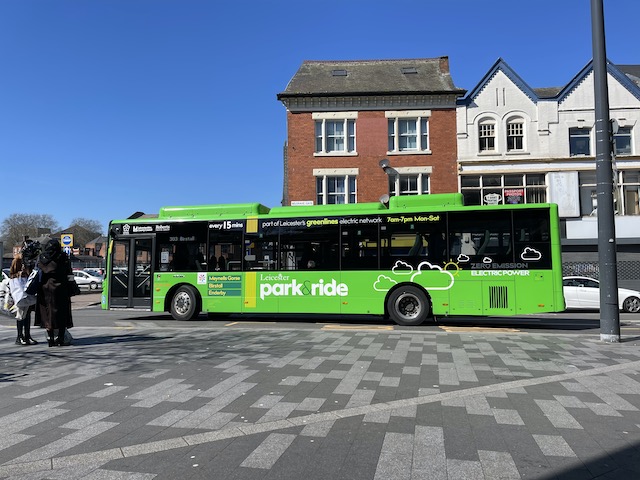
… as well as the hospital hopper…
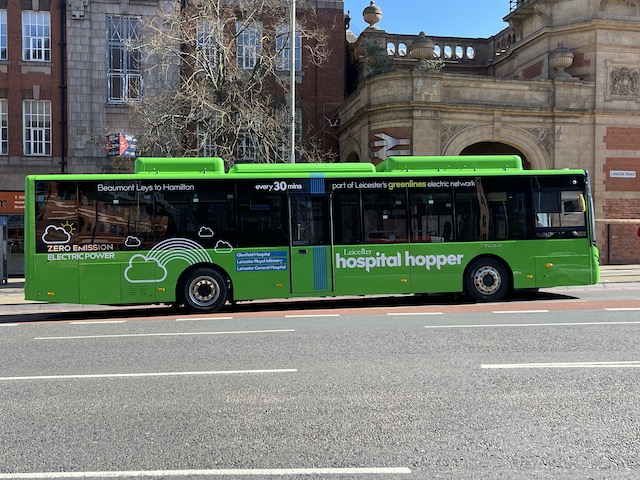
… and the outer circular route 40, now branded orbital (they don’t use capital first letters for brand names in Leicester) and all with battery/electric Yutong buses.
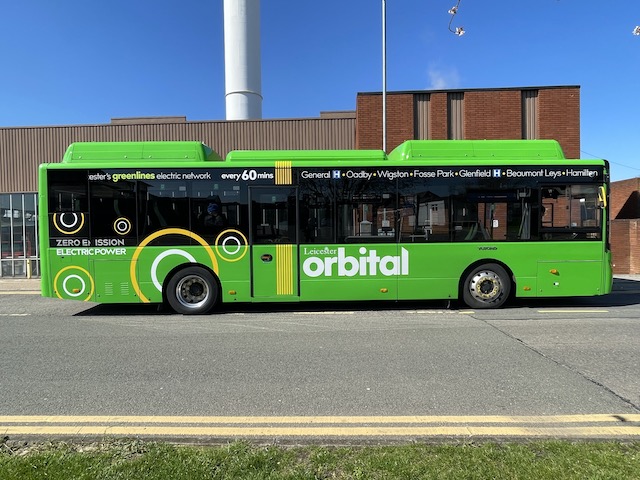
Bizarrely with all the great work it’s doing, Leicester missed out on BSIP (Bus Service Improvement Partnership) funding but working in partnership with the bus operators (Arriva, Centrebus and First Bus) has been successful in securing funds from other sources including ZEBRA (Zero Emission Bus Regional Areas scheme) and particularly the TCF (Transforming Cities Fund).
This latter involves an ambitious £71 million citywide investment programme backed with an award of £32.5 million from the TCF. As well as hop! and its ‘city centre hubs’ (the three buses have cost around £1 million and the hop! promotional budget is £325,000), other projects include improved and expanded Park & Ride, bus lanes and other priority measures, smart ticketing, more real time information and improved waiting facilities at bus stops. Meanwhile First Bus are planning for its Leicester bus garage to become all electric with 86 new electric buses expected by March 2024.

Leicester is making the most of the funding it has managed to secure from Government and the city has certainly become a beacon of good practice for raising the profile of buses and making them attractive. As always with all these things though I worry what will happen when the funding runs out.
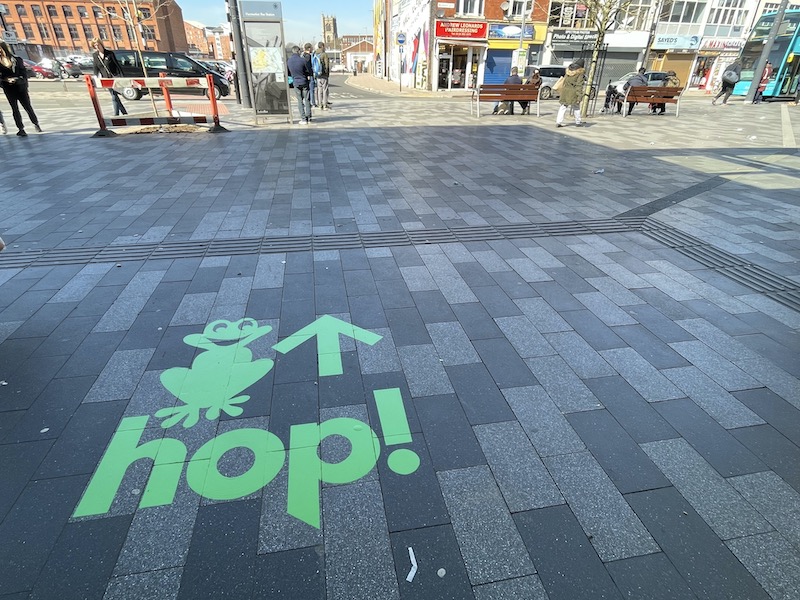
Roger French
Blogging timetable: 06:00 TThS


The only ongoing subsidy as part of the whole programme is Hop, which is an experiment. Hospital Hopper and 40 are existing subsidised services. The Park and Ride passenger numbers are well down on pre COVID numbers so their scope may have to be reviewed.
Centrebus’ farepaying passenger numbers on our Leicester City services have exceeded pre Covid numbers, although ENCTS traffic is still well down.
As is noted Leicester City Council has become a beacon of excellence in the last few years promoting the bus and it was very disheartening for them not the receive any BSIP funding, very lame reasons being offered by the Dft.
There are plans, currently paused, for a workplace parking levy similar to that operated in Nottingham to provide ongoing funding.
LikeLiked by 2 people
There is a good argument for a parking place levy on both workplace parking and Supermarket paring etc and even in some cases council car parks when they are free
Providing Free car parking costs money. There is the cost of the land or lease and business rates and maintenance costs etc. So cars are subsidised but buses are not
One could argue that workplaces and Supermarket should at least match the costs so that buses get the same level of subsidy
One could also argue that government subsidy for bus services should be improved, One can demonstrate at least statistically reductions in pollution.. congestion and accidents which in turn reduces police, NHS and Fire service costs. How you quantify it I am not sure
O The biggest constraints in my view to getting increased bus patronage is simply lack of service. If the service are not there and do not run when people need them and don’t go where people want to go they cannot use them
Poor reliability is another huge issuer particular when service are at a very basic level. One bus missing can leave you stranded for over an hour
Almost total lack of any roadside information is another problem and many LTA’s not even bother with bus stops
Lack of interoperate ticketing is another issue
LikeLiked by 1 person
Somehow a croaking warning sound sounds appropriate for the hop! imagery!
LikeLike
Thank you for your kind words Roger. FWT London lives on and we enjoy working with our friends in Leicester.
LikeLiked by 1 person
Part of the main A50 road near Leicester City Centre is called “Frog Island” – pity the bus doesn’t appear to go there !!
LikeLike
I don’t see the point of this bus other than a tourist attraction, it’s a lot of money to spend on a free bus service which only goes to the bus, train and Richard 3rd centre.
Also, Leicester city is not an attractive town centre, closed down shops, rough sleepers etc, the council would be better using any funding to improve the many really grotty 60’s and 70’s high rise buildings and regenerate those derelect areas, which frankly there are too many of.
LikeLike
Leicester City Transport was always light years in front of other urban operators. I recall being astounded by a 1969 visit to the Control room in Rutland Street, to find all main roads into the City were monitored by CCTV, thus allowing the Controller to regulate services. A situation that put most others to shame, certainly including London Transport.
Whilst government funding is always to be welcomed, provided not thrown at useless DRT projects which will inevitably crash and burn, by NOT getting funded, more sustainable options get explored and as shown by Nottingham, workplace parking levies can be much more cash reliable in the long-term.
LikeLiked by 1 person
Thanks Roger, glad you liked it.
The important point to note is that our overall progress has NOT been achieved by using an alternative funding stream to BSIP – there is difference TIMING here.
Most of our funding streams AND our subsequent planning work for each Enhanced Partnership commitment came several years before BSIP-funding was received, and ages before any BSIP projects will actually be delivered.
The issue is that we’ve now fully committed this existing funding and will have completed 99 of our 100 EP commitments by the end of this year.
So if we had been awarded BSIP funding we could have swiftly built directly on our previous EP progress from next year onwards.
DfT has missed a significant opportunity to promote the National Bus Strategy through using Leicester as an early exemplar.
Andy
PS. If anyone wants to hear the sound of the Hop!, its on :
http://www.leicesterbuses.co.uk/hop
(scroll down to black box)
LikeLiked by 2 people
Keep up the great work Andy.
LikeLike
A free bus ride around Leicester is unfair competition for the railways.
LikeLike
Surely it benefits the railway in providing a service from the station to the city centre. It’s not in competition with the railway.
LikeLiked by 2 people
Unfair competition for the railway? Would this be the same railway that gets billions in public subsidy compared to the bus industry that receives- effectively – the loose coins from down the back of the HMT sofa? 😀
LikeLiked by 1 person
How is a bus (free or otherwise) linking the city centre and the railway station competition for the railway?
My only criticism, and a minor one at that, is that it stops opposite the station rather than outside it, but the road layout outside Leicester station is such that the stop chosen is the best option.
LikeLiked by 1 person
I suppose that those buses have USB ports as they could be used on other routes at some point which are longer.That box looks like a little pistol safe!As it has vents on it’s sides it would suggest that whatever is in it requires cooling.
LikeLike
I wonder if the lack of a terminus might lead to the bus becoming a place for lonely or homeless people to sit all day?
LikeLike
It could potentially be an extra Warm Space in a cold snap and as long as such people aren’t crowding out other passengers then I don’t see a real issue.
It is a providing a social rather than commercial service, after all. 🙂
LikeLiked by 1 person
Hop has carried over 400 passengers a day from day 2
LikeLiked by 1 person
When Suffolk County Council moved their offices from the centre of Ipswich to one slightly further out, they put on a free circular town centre services, ostensibly for the workers but open to all. This ran for quite a few years as a one-bus service, doubled at lunchtimes. When SCC withdrew funding c.2015 it became an ordinary Ipswich Buses service, using only one bus and only running in the middle of the day. Now – alas – it is gone.
LikeLiked by 1 person
I get the impression that SCC has little interest in bus services. It must be up there as one of the worst LTA’s for bus service support
LikeLiked by 1 person
Well done Leicester! I look forward to following future developments.
LikeLiked by 1 person
Do the E-Ink displays follow the normal convention? i.e. If time shown is in hours and minutes it is just timetable time and if just minutes it should be showing real time
The above is really shown anywhere so most people think these displays automatically show real time when frequently they do not
Can the displays show last minute cancellations such as if a bus breaks down?
LikeLiked by 1 person